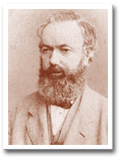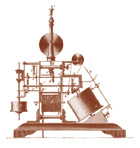|
|

IET Archives |
|
|
Alexander Bain (1811–1877) |
Pictures via a pendulum
The invention of the fax machine
Sending images through telephone lines to be reconstructed at the
receiver’s end as a facsimile of the original — or fax — is nowadays being
overtaken by other forms of electronic communication. But remotely printed paper
messages still have many uses, and have done for more than 150 years. It might
surprise you to know that the fax machine was invented decades before the
telephone.
|

Marius Rensen |
|
Illustration of Bain’s machine in 1850 |
The Scottish shepherd
Sending a message by wire became possible with the start of telegraphy. But
what about the amazing prospect of sending a signature or picture? In answer to
the question in last month’s Pioneers’ Page, this technique was first
demonstrated in the 1840s by a Scotsman, Alexander Bain.
Bain was born in 1811 in Caithness, in the far north of Scotland, one of
13 children of a crofter. As a boy, he helped to look after the sheep, but on
leaving home he trained as a clockmaker, eventually moving to London in 1837 to
pursue his trade. As well as mechanical devices, Bain was fascinated by
electricity. In 1841, he patented the world’s first electric clock, which worked
with a pendulum moved by electromagnetic impulses; this was to be an important
step on the road towards the fax machine, which became Bain’s next invention.
|
In 1902, Arthur Korn, of Germany, demonstrated the first photoelectric fax system, and in 1922 one based on radio signals. Faxes became widely used for transmitting newspaper content and weather maps. ITU played an important role by approving the fi rst international standards for fax machines (Group 1) in 1968, followed by Group 2 standards in 1972 and Group 3 in 1980. The time needed to transmit a page was reduced from six minutes to less than one, and the standards were essential factors behind the boom in fax technology of the 1980s. |
A vital element of his "recording telegraph" was synchronization of the
pendulums of two clocks which, for the scientist’s initial experiments, were
about 70 kilometres apart in Edinburgh and Glasgow. Whenever the Edinburgh
pendulum moved, a pulse of electricity went along a telegraph wire to a solenoid
on the Glasgow pendulum that moved it simultaneously. Attached to each pendulum
was a metal stylus. At Edinburgh, this swept backwards and forwards across a
picture etched in copper (or, later, printer’s type), and when it met a line in
the drawing an electrical contact was made. The signal made the Glasgow pendulum
move across paper soaked in potassium iodide, which changes colour when an
electrical current passes through it.
Scanning line-by-line
A crucial feature of the recording telegraph was its use of scanning. The
copper picture that was being transmitted was moved along by tiny amounts with
each sweep of the pendulum; at the receiving end, the sensitive paper was on a
roll that advanced with each stroke. Thus, a facsimile image was gradually
constructed, line by line.
Bain was granted a British patent on his device in 1843. His invention was
later improved by another Briton, Frederick Bakewell, whose system used
revolving drums covered with tin foil. The image was drawn onto the transmitting
drum with a non-conductive material. The drum was then scanned, while at the
receiving end, an image was produced on chemically treated paper wrapped around
the second drum. Bakewell gave the first public demonstration of a fax
transmission in 1851 at the Great Exhibition in London.
The Italian priest
Despite these successes, it remained a problem to achieve perfect
synchronization of the transmitting and receiving ends of the first fax systems.
The challenge was taken up by an Italian priest, Giovanni Caselli (1815–1891),
who researched into the telegraphic transmission of images while teaching
physics at the University of Florence. In 1860, working in Paris, he built a
machine that he named a "pantelegraph". Essentially a giant, 2-metre-tall
version of the earlier devices, it overcame the synchronization problem by
triggering pendulum movements with extremely accurate clocks that operated
independently of the electric current sent down the telegraph line.
|
|

Marius Rensen |
|
Caselli’s pantelegraph
|
|

Alex de Carvalho |
|
Giovanni Caselli was reportedly given the task of
constructing the famous pendulum of French physicist J.B. Léon Foucault, which
was used to demonstrate the rotation of the Earth |
The pantelegraph was widely acclaimed, and France’s Emperor Napoleon III gave
it his backing. Caselli was allowed to use a telegraph line between Paris and
Amiens to test the device, which he patented in 1861. A commercial fax service
was started in 1863 between Paris and Marseille, followed in 1865 by one between
Paris and Lyon. Thousands of faxes were now being sent across France by
pantelegraph.
However, the pantelegraph failed to become a long-term success. It was not
promoted well enough, and more simple forms of telegraphic transmission
ultimately prevailed. It serves as an example of a technology that did not find
a niche because it was ahead of its time. Nevertheless, four years before the
birth in Scotland of Alexander Graham Bell who patented the telephone, Scotsman
Alexander Bain had arrived at the concept of image scanning that was to be the
basis of not only the fax technology of the future, but also of a fundamental
technique of television.
| |
Question for next time
Printing words mechanically was another way to send writing by telegraph. In
what year was the typewriter first patented?
|
|
|


